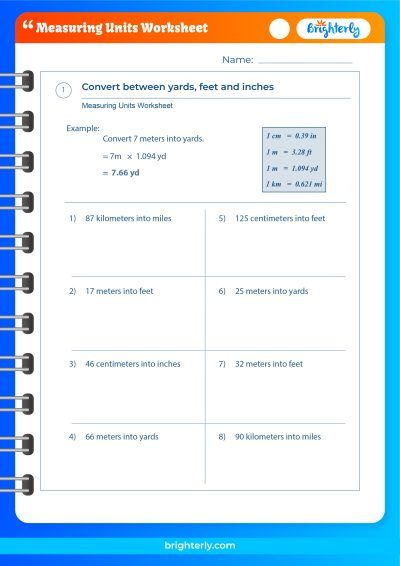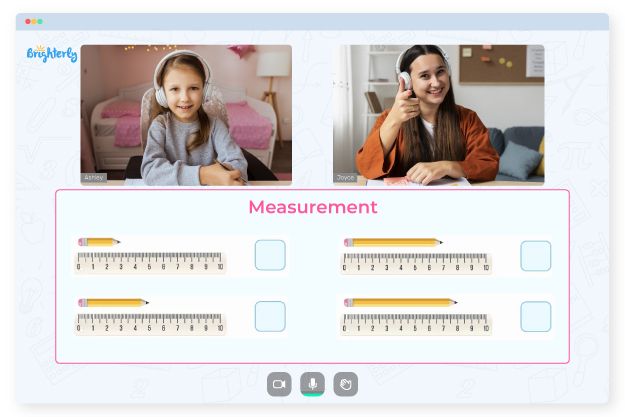Customary Units of Measurement – Definition with Examples
Updated on January 10, 2024
Welcome to another fascinating journey into the world of mathematics with Brighterly! Today, we’re going to delve into the realm of Customary Units of Measurement. As a part of our everyday lives, these units are used for everything from measuring the ingredients for your favorite recipe to determining the distance of your weekend road trip. Whether you are a student trying to master these units or a parent trying to help your child understand them, we’ve got you covered with definitions, examples, and the historical context that makes learning a vibrant experience.
Customary Units: Introduction
Welcome to the captivating world of Customary Units of Measurement! As we embark on this journey with Brighterly, you’ll discover that these units are not merely mathematical entities but rather pieces of history woven into the fabric of everyday life. From the construction of our homes to the food we cook, customary units play a significant role in our daily experiences, especially in the United States.
In this exploration, we will dive deep into the history and evolution of customary units, understand their definitions and relevance, and learn how they continue to influence our lives today. So, buckle up and get ready for an exciting adventure through the world of mathematics with Brighterly!
Definition of Customary Units
Customary units represent a system of measurements that have been traditionally used in a specific country or region. These units have been passed down through generations, carrying with them a legacy of historical systems of measurement. For instance, the United States primarily uses U.S. customary units, which find their origin in the British Imperial System.
Far from being confined to the realm of academic textbooks, customary units permeate our day-to-day activities. They help us navigate the world around us, from baking a scrumptious cake to estimating the distance of our morning run.
U.S. Customary Units
The U.S. Customary Units are a unique system of measurements that have been deeply ingrained in American culture. They comprise units of length, weight, capacity, area, volume, and temperature. Although it may seem bewildering at first, grasping these units becomes straightforward and engaging when explored with real-life examples and historical context.
Customary System
The Customary System used in the United States is a non-metric system of measurement that sets it apart from the metric system adopted by most other countries. This system is a direct descendant of the English units that were prevalent during the colonization of North America. As such, the Customary System serves as a living testament to the rich history and heritage of the United States.
You can discover more detailed responses to these questions and engage in more practice with our interactive Customary Units Conversion Worksheets. This resource has been carefully designed by Brighterly to offer a comprehensive understanding of customary units and their conversions, supplemented with a variety of practical examples and exercises.
Customary Units of Length
In the U.S. Customary System, the primary units of length are inches, feet, yards, and miles. To illustrate, 12 inches make a foot, 3 feet make a yard, and 1760 yards or 5280 feet make a mile. It’s fascinating to observe how these measurements have stood the test of time, finding continued relevance in diverse fields such as construction, transportation, and even athletics.
Customary Units of Weight
The U.S. Customary System measures weight using ounces, pounds, and tons. As a reminder – 16 ounces make a pound, and 2000 pounds make a ton. These units are frequently employed in everyday scenarios, such as grocery shopping or assessing the weight of vehicles. The enduring usage of these units speaks to their resilience and deep-rooted connection to the past.
Customary Units of Capacity
In the realm of capacity, the U.S. Customary System features fluid ounces, cups, pints, quarts, and gallons. To offer some perspective, 8 fluid ounces make a cup, 2 cups make a pint, 2 pints make a quart, and 4 quarts make a gallon. These units form the backbone of the culinary arts, enabling us to create delicious recipes that have been passed down through generations.
Customary Units of Area
Moving forward in our exploration, we encounter the customary units used to measure area. This includes square inches, square feet, square yards, and square miles. Picture a square foot as an area that a square with each side of 1 foot covers. Similarly, a square yard corresponds to a square with sides of 1 yard each.
Imagine a small garden patch, a basketball court, or the vast expanse of a city – each of these can be measured using customary units of area. This system, rooted in tradition, allows us to appreciate and quantify the spaces around us. As you walk around your neighborhood or explore new places, try estimating their areas using these units. It’s a fun and practical way to use the knowledge you’ve gained with Brighterly!
Customary Units of Volume
The U.S. Customary System measures volume in cubic inches, cubic feet, and cubic yards. Consider a cubic foot. It represents the volume that a cube with each side measuring 1 foot occupies. This unit might be used to measure something as everyday as a refrigerator or as vast as a shipping container.
Think of it this way – every time we pour water into a glass or pack a moving box, we are unconsciously using customary units of volume. These units, embedded in our routines, help us make sense of the world around us, one cubic foot at a time.
Customary Units of Temperature
In the customary system, temperature is gauged in degrees Fahrenheit. This scale differs from the metric system, which uses degrees Celsius. For instance, under standard conditions, water freezes at 32 degrees Fahrenheit and boils at 212 degrees Fahrenheit.
Temperature plays a critical role in our lives, influencing everything from the weather to cooking. Understanding the Fahrenheit scale allows us to better navigate these aspects, adding another dimension to our exploration of customary units with Brighterly.
Metric System vs. Customary System
The primary distinction between the Metric and Customary Systems lies in their units and conversion methods. The Metric System, adopted globally, uses a base-10 system, simplifying calculations and conversions. In contrast, the Customary System, with its distinct units and conversion values, adds a layer of cultural heritage and familiarity.
While the Metric System’s uniformity and simplicity make it a universal language of measurement, the Customary System, particularly in the U.S., offers a unique blend of history, tradition, and practical application. The choice between the two isn’t about superiority but rather about understanding and appreciating the strengths and characteristics of each. With Brighterly, we hope you will continue to explore and value both these systems in your mathematical journey.
Solved Examples on Customary Units
Let’s take a look at a couple of solved examples to better understand customary units:
-
If John runs 3 miles every day, how many feet does he run? Since 1 mile is equal to 5280 feet, John runs 3*5280 = 15840 feet every day.
-
Emily bakes a cake that requires 4 cups of flour. If she only has a pint measure, how many pints of flour will she need? Given that 1 pint equals 2 cups, Emily will need 4/2 = 2 pints of flour.
Practice Problems on Customary Units
Now, it’s time for you to practice! Try to solve these problems:
- Convert 9000 feet into miles.
- If a tank holds 8 gallons of water, how many quarts of water can it hold?
Conclusion
In the grand tapestry of mathematics, understanding Customary Units of Measurement plays an essential role. It helps us not only to excel academically but also to apply these concepts in our day-to-day life. Just imagine, wouldn’t it be challenging to follow a recipe without knowing the difference between a cup and a pint, or to understand how far Los Angeles is from New York without knowing what a mile is?
At Brighterly, we believe in making learning a fun and engaging experience. We hope that our exploration of customary units has not only clarified these measurements but also highlighted the richness and diversity of mathematical systems. Remember, each unit, each measurement, carries with it a piece of history and cultural significance. As you continue on your mathematical journey with us, we hope you’ll carry this understanding and appreciation with you.
Embrace these units, use them in your daily life, teach them to others, and keep the tradition alive. After all, learning is not just about gaining knowledge; it’s about understanding our roots and culture. The U.S. Customary Units are not just about numbers; they are a significant part of American heritage.
At Brighterly, we’re dedicated to making learning accessible and enjoyable for children. We’re glad to have you with us on this journey. Stay tuned for more exciting explorations into the world of mathematics, and remember, every unit counts!
Frequently Asked Questions on Customary Units
What are the customary units of length?
The customary units of length form a fascinating chain of measurements that include inches, feet, yards, and miles. These units originate from the human scale of measurement. An inch was originally the width of a grown man’s thumb, a foot was literally based on the length of a human foot, and a yard was the distance from a man’s nose to the tip of his outstretched arm. These units are still widely used today in various fields, such as construction, where materials are often measured in feet and inches, and transportation, where distances are commonly measured in miles.
What is a customary unit of weight?
When we talk about customary units of weight, we’re referring to ounces, pounds, and tons. These units are deeply ingrained in everyday life in the U.S. The ounce, originally defined as the weight of a wheat grain, is often used in cooking and mailing letters. The pound, which historically was the weight of 7000 wheat grains, is now commonly used in grocery stores and gyms. The ton, which is equal to 2000 pounds, is typically used for larger weights like cars or elephants!
Which countries use the customary system?
The U.S. is the primary user of the customary system today, a legacy of the British Imperial System from the colonial era. These units are used in various sectors such as transportation, construction, agriculture, and even in the daily lives of people for measurements of all kinds. However, it’s interesting to note that the U.S. customary units and British Imperial units, while similar, are not entirely identical. For example, a U.S. gallon is smaller than a British gallon. The U.S. is unique in its extensive use of this system, making it a fascinating study of cultural and historical continuity.
Information Sources:
- U.S. Customary Units: National Institute of Standards and Technology
- Customary Units: Wikipedia
- Customary and Metric units: U.S. Department of Education






